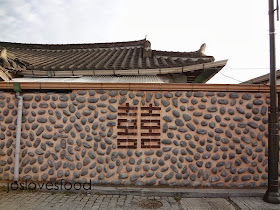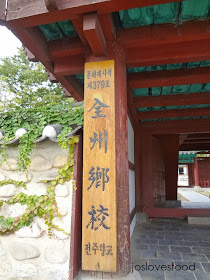Tuesday, October 01, 2013
[Jeollabuk-do, Korea] Autumn Series: Exploring In and Around the Jeonju Hanok Village
전주 한옥마을에 가자! Jeonju is an ancient city located in the Jeolla province, south of Seoul. It is the home to pansori, a genre of musical story-telling, and is famous for the hanok village (Korean traditional houses) and hanji (Korean traditional paper). The city is famous for 2 cuisines, bibimbap (Warm rice topped with various coloured ingredients) and hanjeonsik (Korean's traditional full-course meal).
Jeonju has more than 800 traditional houses, the largest cluster of traditional houses in Korea. These houses were built decades ago and have been preserved to date for its historical charms and traditions.
Staying in hanok (Korean traditional houses) brings travelling in Korea to a new dimension. Over there, I learnt what it means to be "back to basics" and how "communal living" is like in a traditional manner. The rooms were constructed in a way that faces a common area where communal activities can be carried out.
The interior and exterior of the houses were made of natural materials, mainly wood and paper. Notice the stacks of logs at the side of the house? These were used to maintain the traditional ondol floor-heating system since Koreans enjoy sitting, eating and sleeping on the floor. Heat maintenance is particularly important especially during the colder seasons (late autumn until early spring).
The room facilities were really basic. No TV, no attached bathrooms. Common bathrooms are limited in number and queuing to use the toilet and bathroom took a while. Fortunately, there was hot water for shower. Even though, using common bathrooms did present some inconvenience especially since my room was furthest away from it. Not only did I have to ensure that my shower bag was fully equipped with stuff that I did, I had to put on additional clothing when I visit the toilet to avoid catching a cold. It would definitely be worse during winter, having to brave through the chilly weather just to get to the use the toilet!
In the room, there was just a simple dressing table, a fridge and mattresses for sleeping. The furnishings included a double-layered window and a double-layer door made of wood and paper. The paper isn't any ordinary paper but hanji, which is extremely durable. To date, hanji is used for even modern home decorations.
The walls surrounding the traditional houses were low and made using bricks and stones. Some even had decorations on it, such as the word "喜喜" representing double happiness. Take a stroll down the "Slow City" of Jeonju and experience a sense of tranquillity in this little town.
The Jeonju Hyanggyo (Confucian School) was around the vicinity of the hanok village. It was a Confucian School established during the Joseon Period (1392-1910) and is currently a designated historial treasure no. 379. The school was originally located in the Gyeonggijeon and was relocated to the present site in 1603.
In the center of Daeseongjeon are the 5 tablets of Confucius Philosopher, Kongzi, Yangzi, Tsengtzu, Zishi, and Mengzi. There are five big and old ginkgo trees in Confucian School, the one in front of West gate in Confucian school is 400 years old. It is said that the meaning of planting ginkgo trees in Confucian school is for students of Confucianism to become an upright person as the ginkgo trees do not get infested with insects.
As I walked along the clean and quiet alleys, I can't help noticing the beautiful cloudy sky since the buildings were low, mostly in single storey.
The little town is complete with services and facilities for shopping, eating and public services. The above is a small post office by Korea Post.
There is also a little dessert shop that sold patbingsu, shaved ice which is a popular Korean summer dessert, complete with red bean and rice cakes. In fact, the shop serves only 3 types of desserts. That's how simple life was in the town.
Back in the hanok house, the backyard is filled with homemade gochujang, a savoury and pungent Korean condiment made from red chilli, glutinous rice and fermented soy beans and salt. The traditional way of making gochujang was to let the ingredients ferment for years in the large earthen pots left outdoors. I suppose with modernisation, such ways of making gochujang could only be found in the country side or at such traditional houses. It was an eye opener to see so many large earthern pots lining in the backyard.
With the relaxing pace of life and closeness to nature in the hanok village, it is an experience which is difficult or almost impossible to find in our present city life.
Getting to Jeonju Hanok Village
Seoul → JeonjuSeoul Central Terminal → Jeonju Express Bus Terminal
(First bus - 05:30 / Last bus - 24:00 / Runs every 10 minutes / Travel time - 2 hours, 45 minutes)
Jeonju Express Bus Terminal → Jeonju Hanok Village
* Take Bus 5-1 from the bus stop located 150m away from the taxi stand on the opposite side of the street (towards Inter-city bus terminal direction).
(Bus runs every 15 minutes / Travel time: around 15 minutes).
* Take Bus 79 from the bus stop in front of the terminal main gate.
(Runs every 25 minutes / Travel time: around 15 minutes).
* Take a taxi: approximately 10 minutes.
Alternatively, take the KTX at Yongsan Station (Station) via the Jeolla line. (~ 2hr 14 mins, 6 stops). At Jeonju station, transfer to bus 513 in the direction of Jeonju Hyanggyo. (~17mins, 13 stops)
View Larger Map

















No comments:
Post a Comment
All comments are welcomed